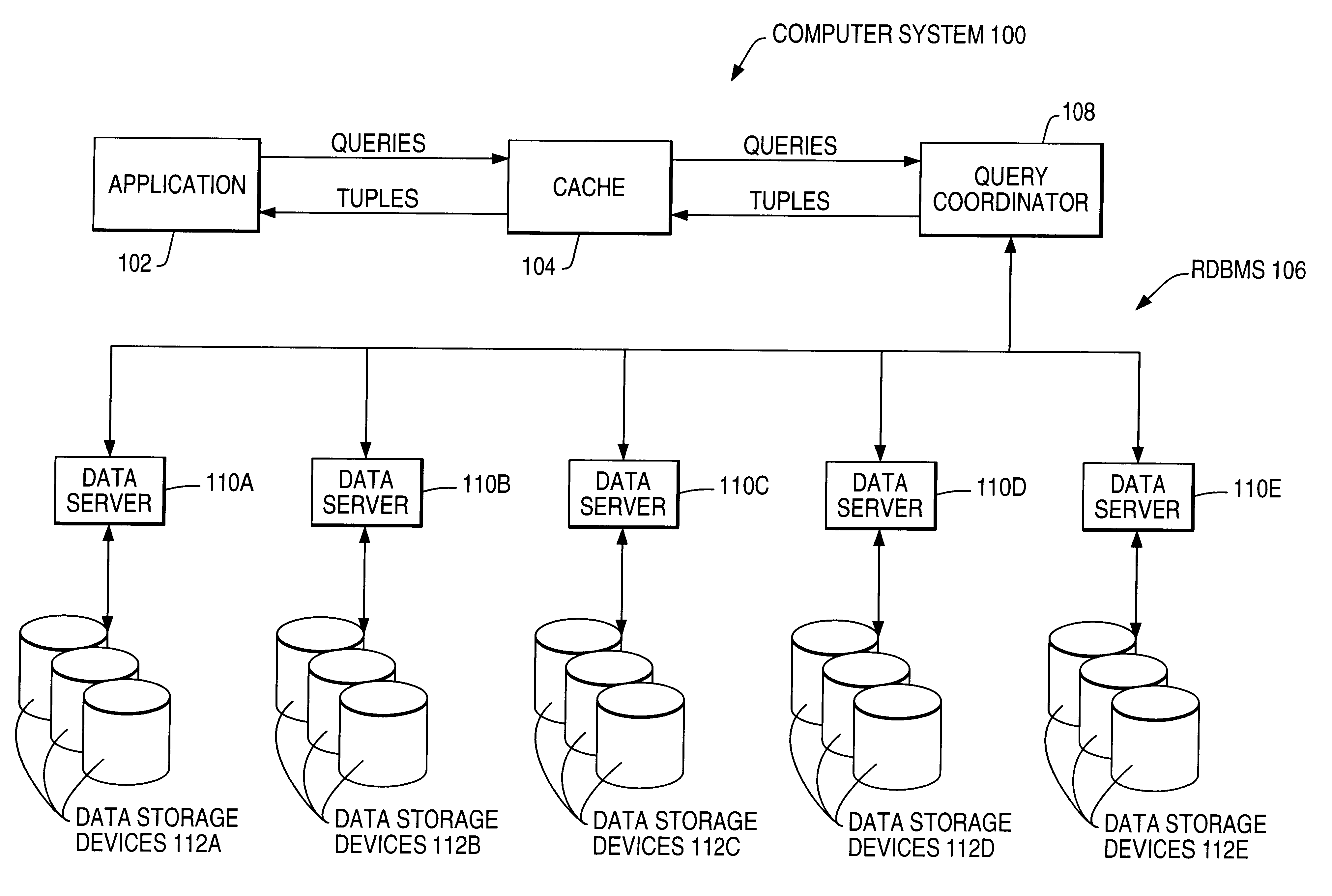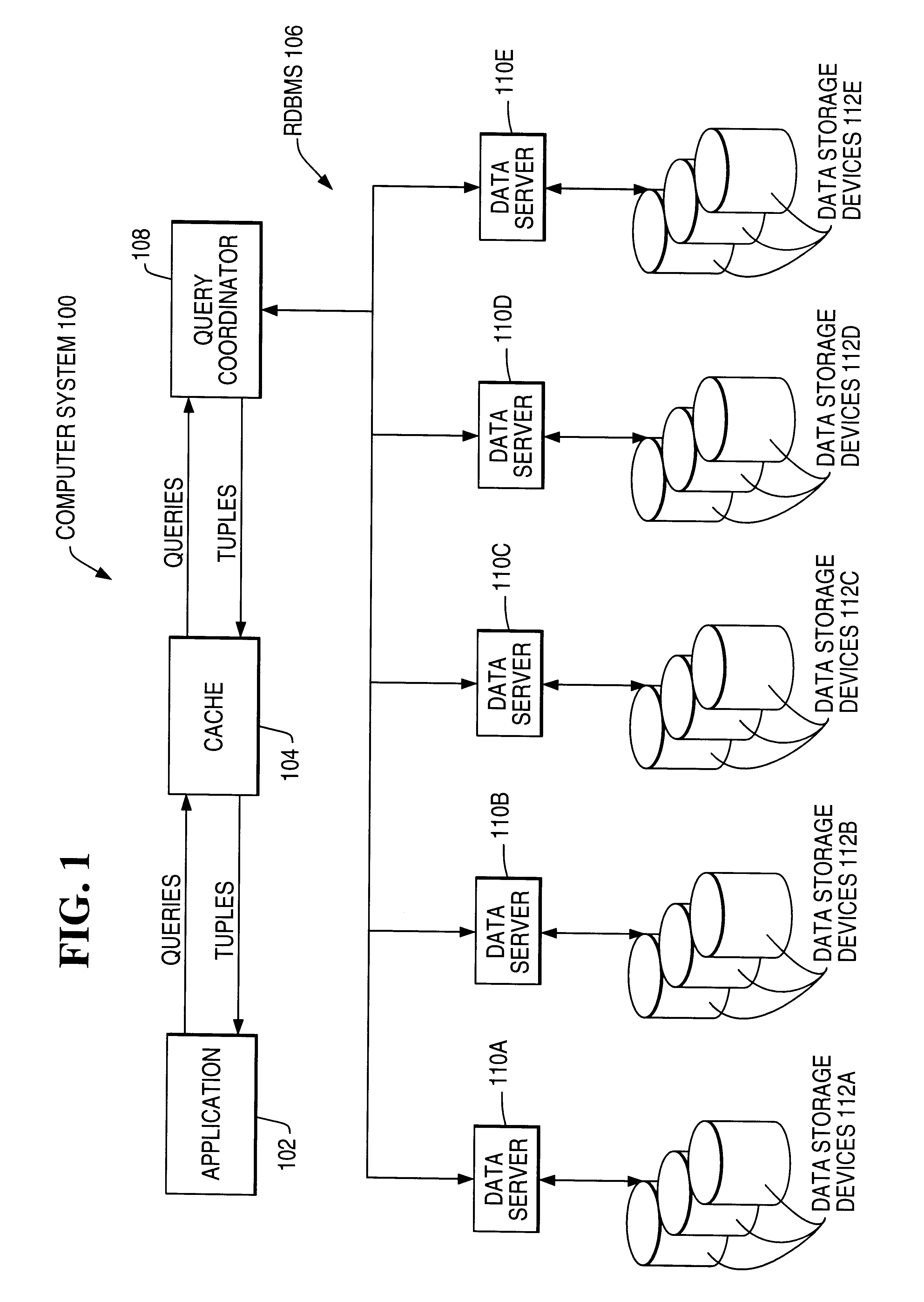Active caching for multi-dimensional data sets in relational database management system
a database management system and multi-dimensional data technology, applied in multi-dimensional databases, data processing applications, instruments, etc., can solve the problems of missing dramatic performance improvement, complex queries in olap systems, and large amounts of data, so as to achieve less structured workload and substantial performance improvement
- Summary
- Abstract
- Description
- Claims
- Application Information
AI Technical Summary
Benefits of technology
Problems solved by technology
Method used
Image
Examples
example 3.1
schema with three dimensions A, B and C Dimension B has a two level hierarchy defined on it, whereas A and C have a single level hierarchy as shown in FIG. 5. FIG. 6 shows the lattice formed by these dimensions, wherein (x, y, z) denotes the level on each of the dimensions, (1, 2, 1) is the most detailed level (A.sub.1 B.sub.2 C.sub.1), and (0, 0, 0) is the most aggregated level (A.sub.0 B.sub.0 C.sub.0).
For any GROUP-BY, there are many GROUP-BYs from which it can be computed. In general, a GROUP-BY (x.sub.1, y.sub.1, z.sub.1) can be computed from (x.sub.2, Y.sub.2, z.sub.2) if x.sub.1.ltoreq.x.sub.2, y.sub.1.ltoreq.y.sub.2 and z.sub.1.ltoreq.z.sub.2. For example, GROUP-BY (0, 2, 0) can be computed from (0, 2, 1) or (1, 2, 0). Thus, there is a need to consider all the parent nodes in the lattice to determine if a particular GROUP-BY query can be answered from the cache 104.
The problem becomes more complex when using the chunk-based caching scheme. Due to the closure property, there ...
example 4.1
small sub-section of a lattice as shown in FIG. 8. Suppose the ESM is searching for chunk 0 at level (0, 0). Two of the paths from (0, 0) intersect at (1, 1). As the ESM searches these two paths, it will search for each of chunks 0, 1, 2 and 3 at level (1, 1) two times, i.e., once for each path. It does not reuse the work done previously.
2. A lot of the work can be reused by maintaining some summary of the state of the cache 104 in terms of some meta-information about each chunk.
In accordance with these observations, the VCM maintains a count for each chunk at each GROUP-BY level. A chunk may be either directly present in the cache 104 or may be computable through some path. Each path has to pass through some parent of that node in the lattice. Thus, the virtual count for a chunk is defined as provided below.
Definition 4.1 (Virtual Count). The virtual count for a chunk indicates the number of parents of that node through which there is a successful computation path. The count is inc...
example 4.2
s a very simple lattice with two dimensions having hierarchy size of 1 each. Level (1, 1) has 4 chunks, levels (1, 0) and (0, 1) have 2 chunks each, and level (0, 0) has only 1 chunk The figure shows the chunks that are present in the cache 104 and the counts maintained by the VCM. Chunk 0 at level: (1, 1) has count 1 since it is present in the cache 104 and that is the only way to compute it. Chunk 1 at level (1, 1) is not computable, nor is it present in the cache 104, thus giving a count of 0. Chunk 0 at level (1, 0) has a count of 1 even though it is not present in the cache 104. This is because there is a successful computation path through one of its parents, i.e., level (1, 1). Chunk 0 at level (0, 0) is present in the cache 104. Also, there are successful computation paths through two of its parents. Thus, the count for chunk 0 at level (0, 0) is 3.
Note that the count is not equal to the total number of ways of computing a chunk but is just indicative of whether a chunk is c...
PUM
 Login to View More
Login to View More Abstract
Description
Claims
Application Information
 Login to View More
Login to View More - R&D
- Intellectual Property
- Life Sciences
- Materials
- Tech Scout
- Unparalleled Data Quality
- Higher Quality Content
- 60% Fewer Hallucinations
Browse by: Latest US Patents, China's latest patents, Technical Efficacy Thesaurus, Application Domain, Technology Topic, Popular Technical Reports.
© 2025 PatSnap. All rights reserved.Legal|Privacy policy|Modern Slavery Act Transparency Statement|Sitemap|About US| Contact US: help@patsnap.com



